GIS Explorers
Description
A multinational company may want to show information about a region or even globally. They can use a graph or table to represent the information but it can be hard to visualise and compare. Using a geographic information system (GIS) explorers, they can display geographic context and use maps to help make better decisions.
The GIS Explorers module provides a flexible interface to manage and display geographic data as well as perform essential GIS functions.
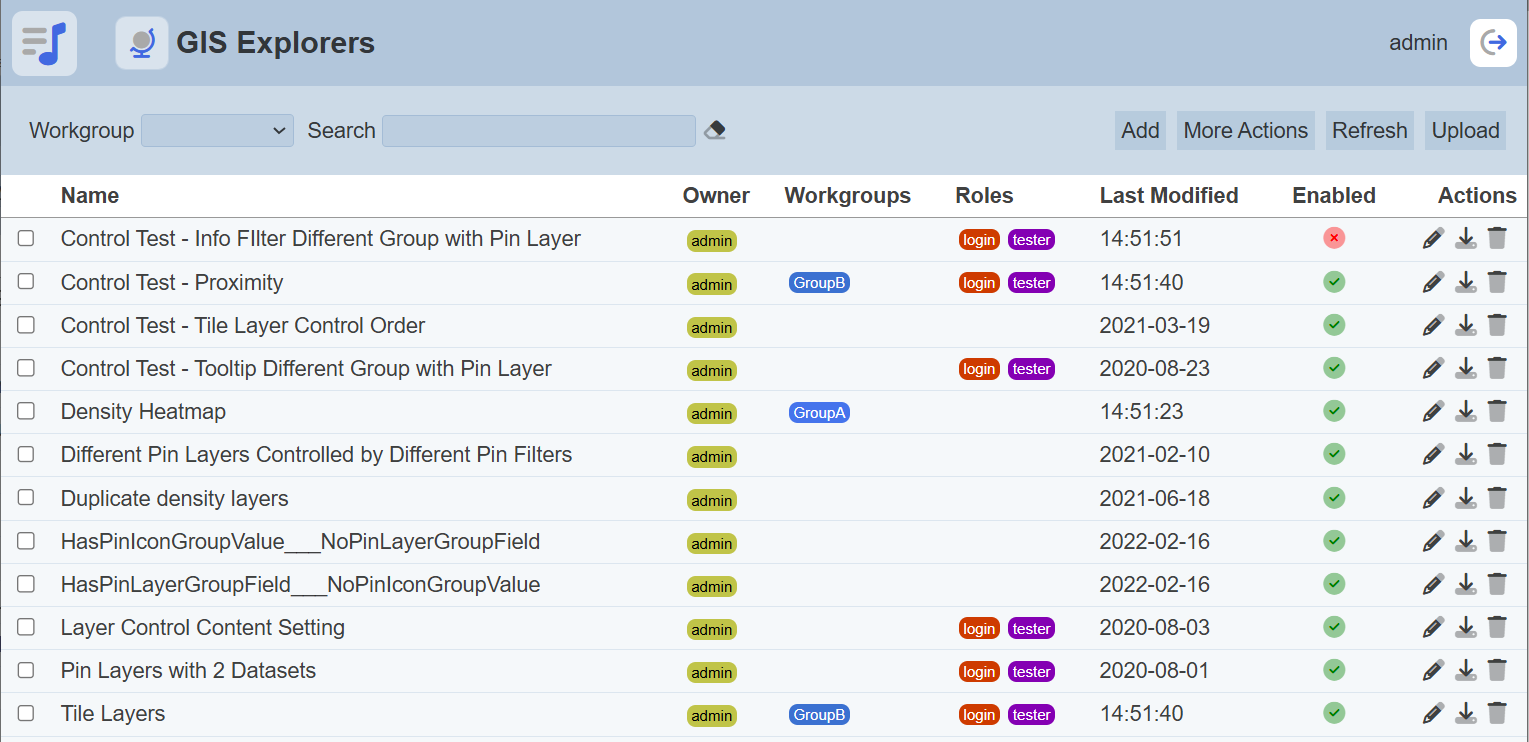
Features
- Add explorer
- Edit explorer
- Upload explorer
- Delete explorer
- Refresh list
- Search
Module Interfaces
| Interface | Description | Required Privilege |
|---|---|---|
| GIS Explorers | Allows GIS Explorers management access | mod-gis-explorers |
| GIS Explorers | Allows edit GIS Explorers management metadata | mod-gis-explorers-edit |
| GIS Explorer | Allows edit GIS Explorer | mod-gis-explorer-edit |
| GIS Explorer | Allows GIS Explorer access | mod-gis-explorer |
Add Explorer
To add a GIS Explorer, start by clicking on the “Add” button on the upper right corner of the page.

In the “New Explorer” dialog box, set the properties for the new explorer.
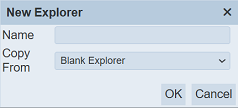
| Field | Description | Mandatory | Input Type | Constraints | Default Value |
|---|---|---|---|---|---|
| Name | Unique name assigned to the explorer. | Y | Text field | Any text (case-sensitive) | Empty string |
| Copy From | Copy from an existing explorer. | Y | Drop-down list | Select from list | Blank explorer |
| Provider | List of providers. | Y | Drop-down list | Select from list | Leaflet |
In “New Explorer” dialog box, key in the name to be given to the explorer into the “Name” field. The “Name” field must be a unique value (not used by other explorers) and it is case-sensitive.
If an existing explorer is selected in the “Copy From” field, the other fields will use the properties from the existing explorer and will not be available. If a blank explorer is selected in the “Copy From” field.
Click on the “OK” button in the “New Explorer” dialog box to create the new blank GIS explorer. Clicking on the “Cancel” button aborts the action. By default, the newly added explorer is enabled.
Once the GIS Explorer is created, the GIS Explorer Wizard will appear to assist user to setup the GIS Explorer.
Refresh
After performing actions on the browser/tab, the list is reloaded to display the explorers. The manual “Refresh” button is available and is particularly useful if there are others making changes on the same page.
The “Refresh” button is found on the upper right corner of the page. Clicking on it reloads the list of explorers.

Upload Explorer
To upload a GIS Explorer, start by clicking on the “Upload” button on the upper right corner of the page.

The “Upload” dialog box appears on the page.
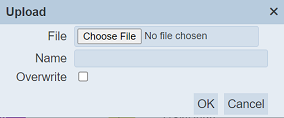
Single File
Browse to the location of the file (<filename>.gis-explorer.json) to be uploaded and set the “Name” field. By default, the “Name” field uses the name of the upload file. You can change it to an appropriate name if desired. If the file to be uploaded is to replace an existing explorer, select the “Overwrite” field. Do note that the “Name” field must be unique, or an error message will appear.
| Field | Description | Mandatory | Input Type | Constraints | Default Value |
|---|---|---|---|---|---|
| Browse File | Browse to select file to be uploaded. | Y | Text field | Any text | Empty string |
| Name | Unique name assigned to the file to be uploaded. When a file is specified in the above field, this field will automatically takes in the file name of the specified file. |
Y | Text field | Any text | Empty string |
| Overwrite | If selected, overwrites existing GIS Explorer. | N | Checkbox | Select or not selected | Not selected |
Click on the “OK” button to upload the selected file. Click on the “Cancel” button to abort the action. A message will appear after the file has been successfully uploaded.

You can arrange/sort the list of GIS Explorers in ascending or descending order by clicking on the name of the desired field. By default, the list is sorted by the “Name” field in ascending order.
Zip File
Browse to the location of the zip file to be uploaded. The name of the explorers will be extracted from the zip file. Click on the “OK” button to upload the explorers. The “Upload Results” dialog box will display the results of the uploading.

Those results in black are uploaded successfully while those in red indicates upload failures with their relevant messages. Click on the “Close” button to close the dialog box.
Edit Explorer
To modify an existing explorer’s attributes, click on the ![]() “Edit” icon under the “Actions” column corresponding the desired explorer.
“Edit” icon under the “Actions” column corresponding the desired explorer.
![]()
The “Edit” dialog box displays the selected explorer’s attributes.
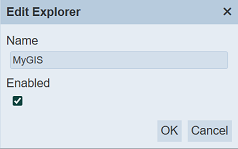
You can change name of the GIS Explorer in the “Name” field. To enable or disable the explorer, select or deselect the “Enabled” field respectively. By default, the explorer is enabled. Disabled explorer will not be able to be used in the dashboard and is unable to access GIS Explorer Designer page.
Click on the “Save” button located on the upper right corner of the “Edit” panel to proceed with saving the changes made to the explorer. Clicking on the “Cancel” button aborts the action and retains the explorer’s attributes prior to opening the “Edit” panel.
Open Explorer
To open the GIS Explorer, click on the name of the desired GIS Explorer under the “Name” column.
The GIS Explorer Designer page will be displayed.
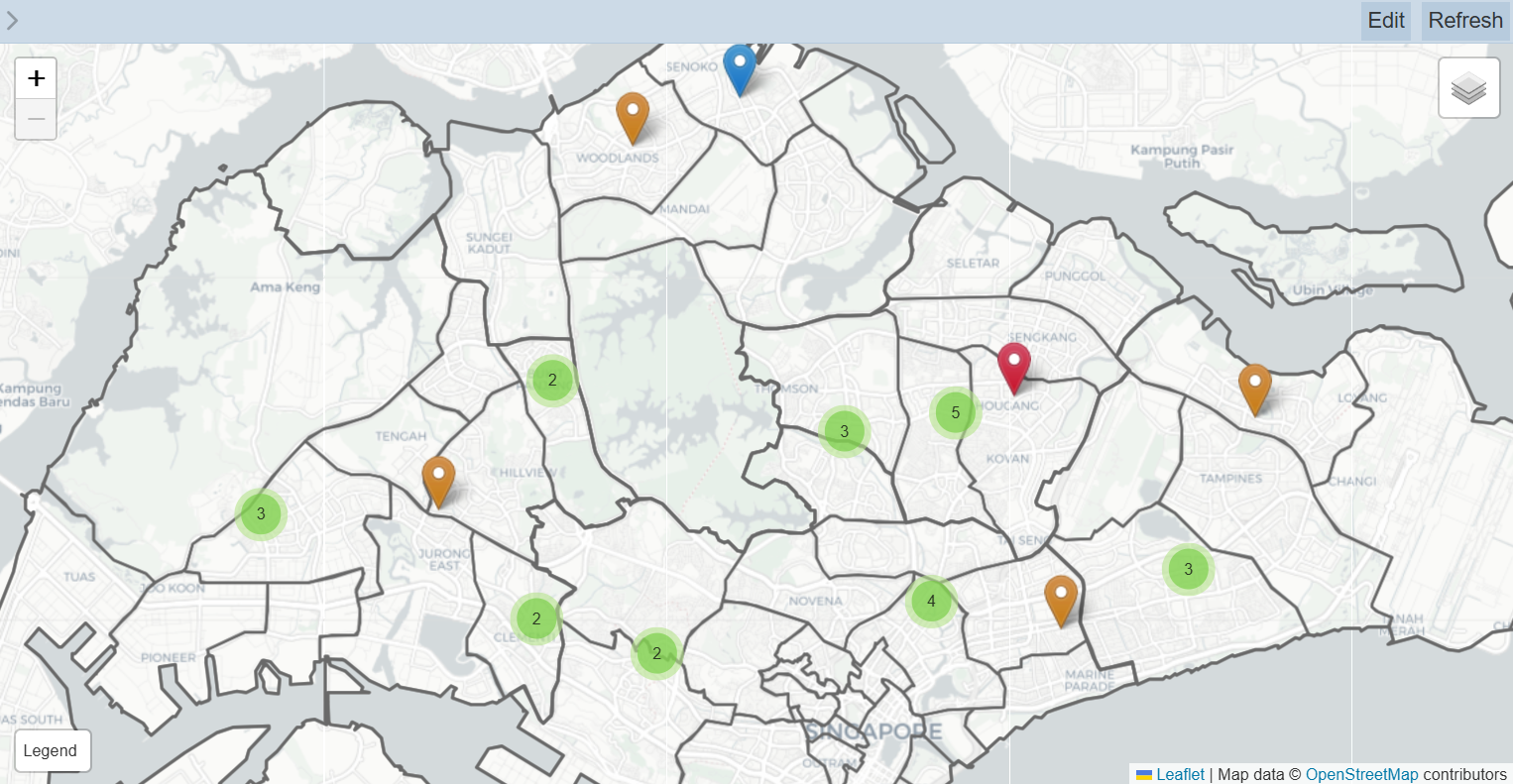
If this is a newly added explorer, the page will appear blank, allowing you to set it up.
Do note that any disabled GIS Explorer will not be able to access the GIS Explorer Designer page.
For more information on the GIS Explorer, see GIS Explorer.
Download Explorer
To download the GIS Explorer, click on the ![]() “Download” icon under the “Actions” column corresponding to the desired explorer.
“Download” icon under the “Actions” column corresponding to the desired explorer.
![]()
The downloaded explorer has the following filename format <filename>.gis-explorer.json.
Delete Explorer
Deleting a GIS Explorer removes it from the records.
To delete an existing explorer from Ambience, click on the  “Delete” icon under the “Actions” column corresponding the desired explorer.
“Delete” icon under the “Actions” column corresponding the desired explorer.
![]()
There is an option to undo the deletion. A notification with an “Undo” button appears right after clicking on the “Delete” icon.

Upon clicking on the “Undo” button, the deleted explorer is restored and is added back to the list of GIS explorer. Do note that the notification will disappear after 5 seconds.
More Actions
This feature allows user to perform actions on multiple GIS Explorers at the same time.
When the “More Actions” button located at the upper right corner of the page is clicked, a list of available actions are displayed.

If no explorer is selected prior clicking the button, there will be fewer actions available. To select a explorer, select the checkbox next to the name of the explorer.
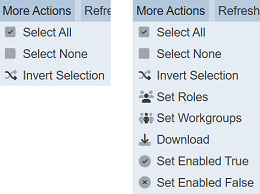
| Option | Description |
|---|---|
| Select All | Selects all explorers in the list. |
| Select None | Unselects all explorers. |
| Invert Selection | Inverts the current selection. That is, any explorers selected will be unselected and vice versa. |
| Set Roles | Selects the roles to be assigned to the explorers. |
| Set Workgroups | Selects the workgroups to be associated with the explorers. |
| Download | Downloads multiple explorers as a zip file. If only one explorer is selected, the selected explorer will be downloaded as a JSON file. |
| Set Enabled True | When selected, sets the selected explorers to enable. |
| Set Enabled False | When selected, sets the selected explorers to disable. |
Set Roles
To set the roles for the selected explorers, click on the “More Actions” button and select the “Set Roles” option. The “Set Roles” dialog box will appear.
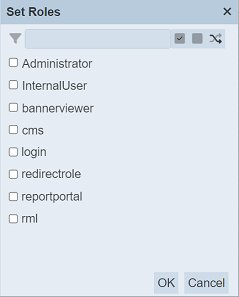
Select the roles to have access to the explorers by selecting the checkboxes. Alternatively, you can search for the desired role by keying in the keyword in the search function at the top of the dialog box. You can also choose to select all, select none or invert selection by clicking on their respective icons on the right of the search function.
Click on the “OK” button to save the changes or click on the “Cancel” button to abort the action.
Set Workgroups
To set the workgroups to be associated with the selected explorers, click on the “More Actions” button and select the “Set Workgroups” option. The “Set Workgroups” dialog box will appear.
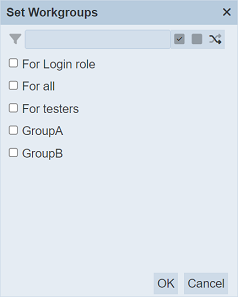
Select the workgroups to be associated with the explorers by selecting the checkboxes. Alternatively, you can search for the desired workgroup by keying in the keyword in the search function at the top of the dialog box. You can also choose to select all, select none or invert selection by clicking on their respective icons on the right of the search function.
Click on the “OK” button to save the changes or click on the “Cancel” button to abort the action.
Download
To download the selected explorers, click on the “More Actions” button and select the “Download” option.
If only one explorer is selected, the downloaded explorer has a filename of <filename>.gis-explorer.json.
If more than one explorer are selected prior, the “Download” dialog box will appear.

Key in the desired name for the zip file and click on the “OK” button. The selected explorers will be downloaded as a zip file with the filename provided earlier. The individual explorer in the zip file will have the filename format as mentioned above.
Set Enabled True / False
To enable or disable the explorers, click on the “More Actions” button and select the “Set Enabled True” or “Set Enabled False” option respectively.
The selected explorers will be enabled or disabled as selected.
An enabled explorer is represented with a green tick under the “Enabled” column, while a disabled explorer is represented with a red cross.
Workgroup
The “Workgroup” field at the top left corner of the page allows you to filter the GIS Explorers associated with the selected workgroup.
Simply select the desired workgroup from the drop-down list and the GIS Explorers associated with the selected workgroup will appear.
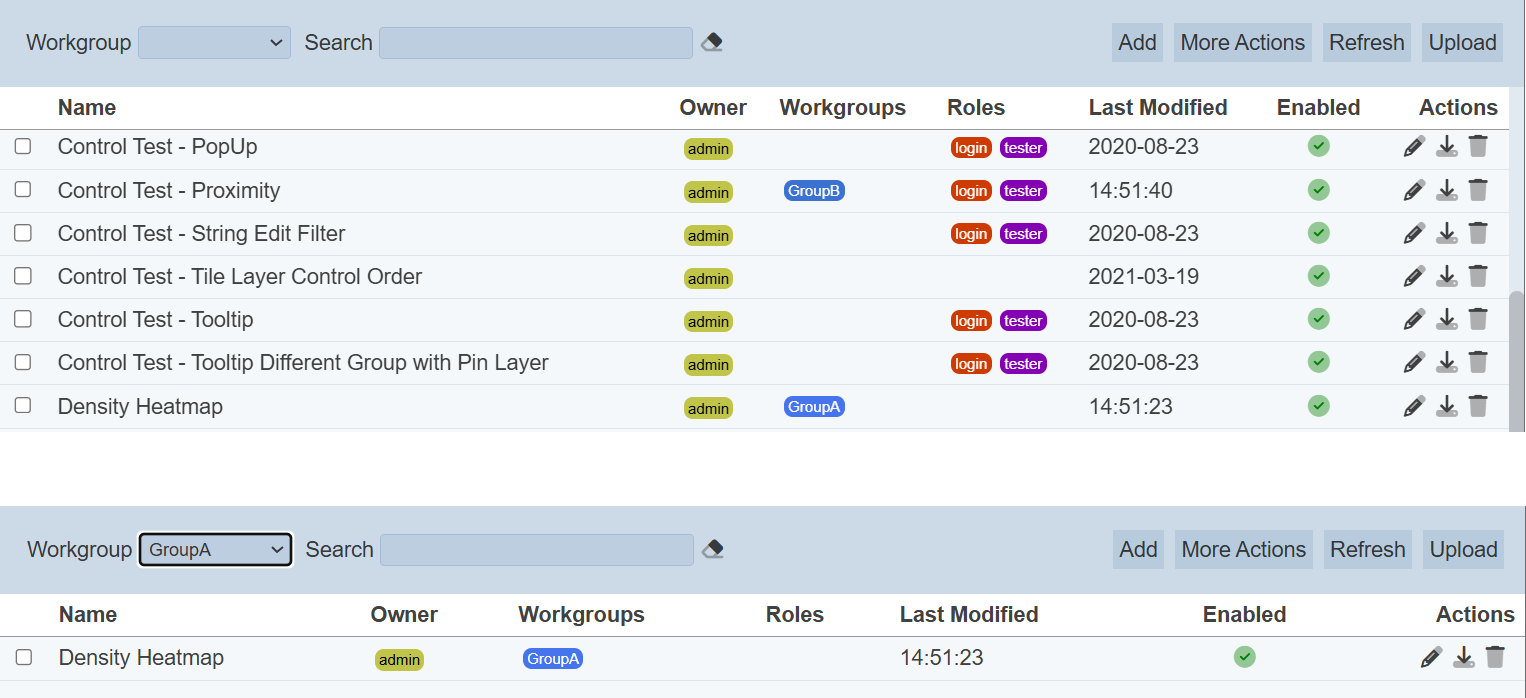
Do note that if no workgroup is created in the Workgroups module, the “Workgroup” field at the top left of the page will not appear.
Search
The search bar appears on the upper left corner of the page.

This provides an easy way to search through the list. It is case-insensitive and displays records that have the entered search value in any of the values of the fields below:
- Name
- Dataset
- Provider
- Owner
- Last Modified
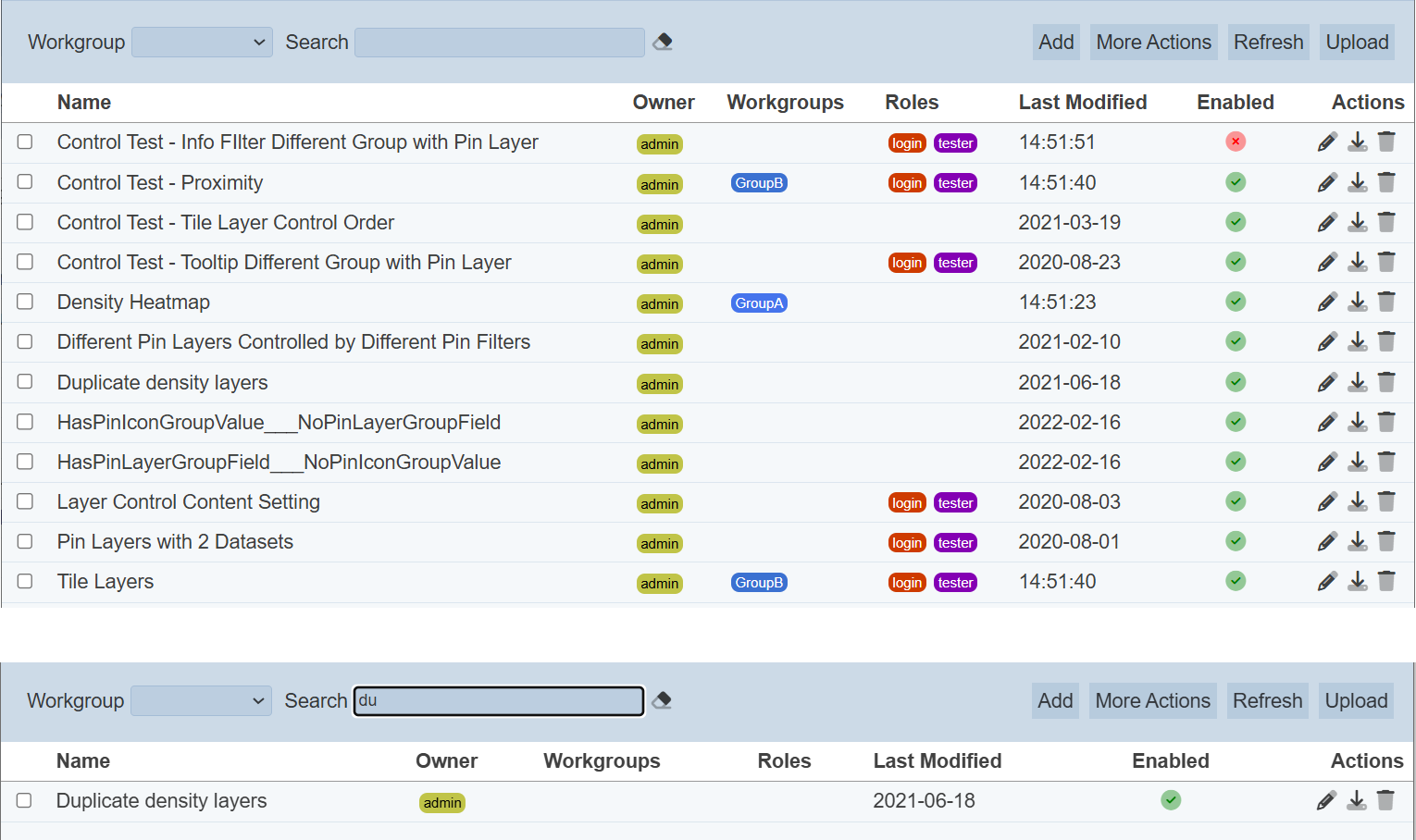
Alternatively, you can click on the any items under the “Owner”, “Workgroups” or “Roles” columns to aid the search for the explorers in the page.

In the example above, GIS Explorer that are associated with the workgroup “GroupA” is shown.
These two search methods can be combined together, with each criteria separated by a comma.
